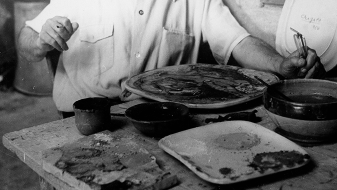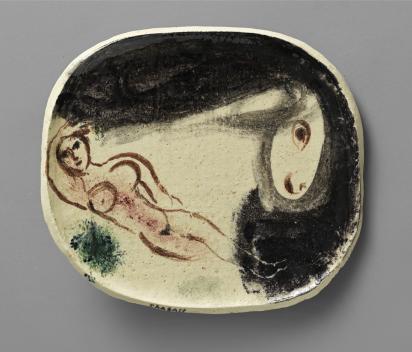Woman on a White Horse (1952) is a rare ceramic piece by Marc Chagall where the main colors are black and white. A simple, rustic plate, it recalls the pottery made in Vallauris in the early 1950s. A white horse carrying a nude woman lightly outlined in brown stands out against a deep black background whose pictorial quality is emphasized by deep brushstrokes. The powerful, hypnotic black background, already seen on the dish Two Faces [Les Deux Visages] (1951), sets off the creamy white enameled horse, treated in reserve and revealing the thick-grained clay used by Chagall and his artisans. This bold choice subtly cuts the outline of the horse off from the background of the plate, making the piece unique and radical. Its simplicity, strong contrasts and visible brushstrokes recall the washes Chagall created in the late 1940s and early 1950s, especially the Decameron series, Boccaccio’s Tales ("The Cook; illustration no. 13 for Boccaccio's Tales, Verve" [Le cuisinier; illustration n°13 pour les Contes de Boccace, Verve] (1949 - 1950)). This piece, which explores the technical possibilities of painting on ceramic, is amongst the closest to the artist's pictorial work. It belongs to a series of nocturnal paintings from the end of the war in which the effects of snow are often combined with the darkness of night to evoke the political upheavals and instability of those troubled times (Lovers with Pole or Couple in Chains [Les Amoureux au poteau ou Couple enchaîné] (1951)).
AMBRE GAUTHIERCeramic
Woman on White Horse
(La Femme sur le cheval blanc)
- No. C-187
- 1952
- Dish
- white grog, decorated with slips and oxides, engraved with a knife, underglaze
- 12 3/16 x 13 3/4 x 1 in. (31 x 35 x 2.5 cm)
-
Signed Chagall below on the edge
Signed Chagall Vallauris on the back
- Pottery studio: Madoura
- Private collection

